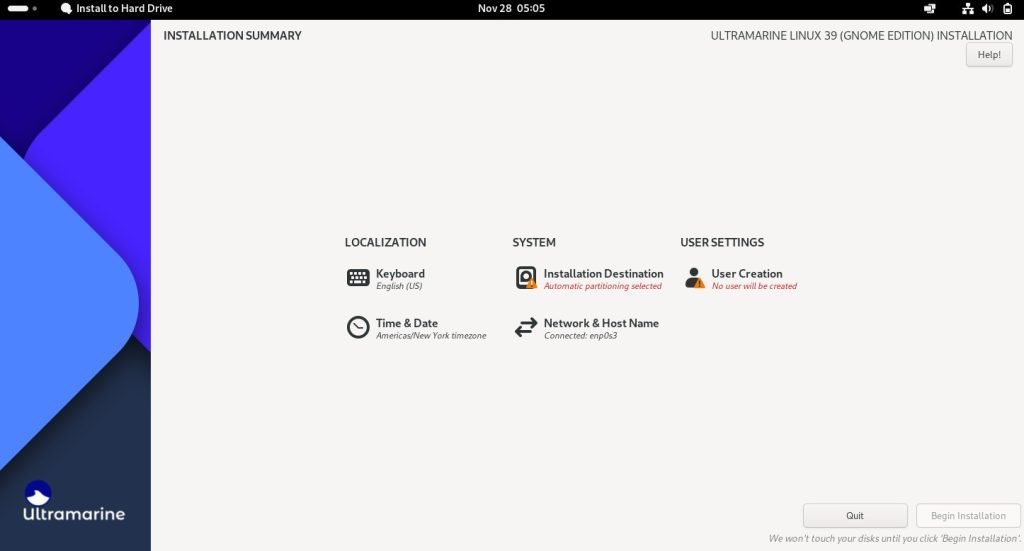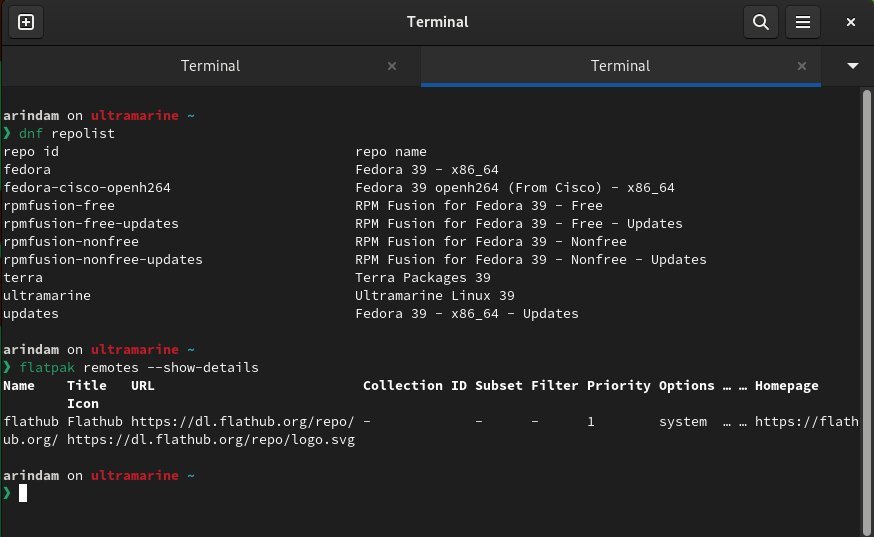Ultramarine Linux distinguishes itself by providing a customized out-of-the-box experience with four desktop flavours while based on Fedora Linux. The Fedora base ensures access to the latest advancements in the Linux world, from the kernel to audio and video technologies.
Ultramarine Linux 39, the latest iteration of this distribution, is a great release with its seamless integration of four desktop environments: Budgie, KDE Plasma, Pantheon, and GNOME. In addition, a few cool features have arrived in this version.
We will take a test drive for you on how it is built and its compelling features.
Table of Contents
Ultramarine Linux 39: Review
Installation
A noteworthy approach in Ultramarine Linux is the availability of separate ISO files for each desktop environment. This not only streamlines the installation process but also keeps the ISO size around a manageable 2 GB.
When you boot up using the LIVE medium, you get a nice popup giving you options to install it.
Utilizing Fedora’s Anaconda installer, the installation is a breeze, offering a hassle-free experience for users.
Desktop Flavors
At the core, Ultramarine Linux 39 features Linux Kernel 6.5. The Kernel 6.6 would soon arrive as soon as it hits Fedora 39.
The Pantheon Edition has made some important changes. From now on, Flatpaks of elementary apps will be used by default. This change is expected to resolve most issues related to these apps. Additionally, the team have fixed some problems with XDG portals and a long-standing bug that prevented wallpapers from setting properly in Pantheon. All these improvements bring the Ultramarine closer to becoming the best way of running Pantheon. That said, if you really miss elementary OS & Pantheon, you should give this edition a try.
Following the Fedora 39 base, the GNOME edition features the GNOME 45 release. This version offers new workspace icons, new adwaita styles in settings and Files, faster search and many new features. You can learn those here: GNOME 45 – Best new features.
The flagship Budgie desktop offers a lightning-fast experience with additional customization options; The Nautilus file manager has been replaced with Nemo. It’s more powerful and looks more coherent with this Flagship edition.
The KDE Plasma edition features the Plasma 5.27 version, the last of the Plasma 5 series. Despite customisations, the KDE Plasma edition in Ultramarine is surprisingly fast in my test.
Differences with stock Fedora
If you compare Ultramarine with the stock Fedora version, there are some differences which you should be aware of.
Firstly, it includes some essential applications by default, such as LibreOffice.
Secondly, the Flatpak & Flathub setup comes by default. You don’t need to separately configure Flathub. This is a huge win.
In addition, the terminal is uber cool with a pre-installed ZSH theme. If you are using the GNOME edition, you should be happy to know that Extensions are pre-configured with the Extensions app. Furthermore, a few cool extensions are pre-installed:
- Appindicator
- App menu is back
- Application menu
- Launch new instance
- Pop shell
- Window list
However, I feel the team should consider the Extension Manager app, which is more robust than Extensions.
Last but not least, the RPM fusion repository is pre-configured with both free and non-free versions. This allows you to access thousands of proprietary packages, media codecs for your Ultramarine system.
Performance
Testing on both virtual machines and physical systems revealed impressive performance across all desktop flavours. Notably, the GNOME desktop maintained a modest RAM usage of 1.2 GB during idle state. Overall, the performance across the board is commendable, making Ultramarine Linux suitable for moderately newer hardware.
As you run more applications, the resource consumption will increase in that ratio.
It uses 3.4 GB of disk space for default installation (GNOME).
Upgrade paths
One of the best features to use this distribution is the upgrade & migration path. The team offers some scripts (see below) by which you can migrate existing stock Fedora installation to Ultramarine Linux. Moreover, you can easily upgrade from the Ultramarine 38 to 39 version using another script.
bash <(curl -s https://ultramarine-linux.org/migrate.sh)
This release also introduces the Raspberry Pi4 and Chromebook images for Ultramarine, expanding the user base.
That said, if you commit to this distribution, you should be all set with future upgrades.
Closing Notes
Ultramarine Linux 39 emerged as a standout Fedora spin, blending advanced technology with visually appealing desktop environments. The team has built a really nice and usable Fedora spin, which can be easily adopted by first-time Fedora users. The inclusion of the key desktops – KDE Plasma, GNOME, Budgie & Pantheon, coupled with the convenience of RPM Fusion, enhances the overall user experience.
This distro, though underrated, deserves recognition and support from the Linux community.
You can download it from the official website.





